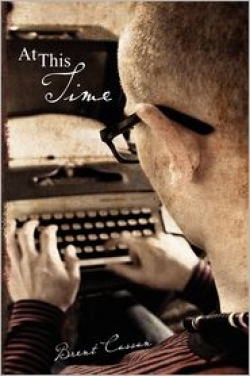At This Time
Brent Cassan’s poetry collection, At This Time, takes the reader on a journey: beginning with Adam’s rib and the banishment of Eve, and moving through history to the laying of rails in America, and on to the “Coney Island alphabet.” This collection is certainly ambitious.
At This Time is a lyrical patchwork quilt. Each poem has a unique shape. Cassan deftly experiments with line breaks, so the indents and line length vary with nearly every piece. Often, the shape of the lines mimics the action of the rich verbs or alludes to poem’s central images. For example, in “The Southern Barrier,” the poem’s lines are indented in and out. This not only mimics the literal terrain of this “southern wall that bears the snow, / mountains enduring the brunt, / defending” but also the forceful charge of “chariots in Rome.” The lines move as quickly as “labor’s spirit and song.” The poem finishes with “machines” that “run, run, run.” There is a sly sense of humor in this piece, especially with its winks at history and meaning.
“Eight Minutes in the Louvre” is sparse, sharp, and to-the-point. Here, the poet uses white space to mimic a speaker wandering in the famous museum. Cassan describes this experience by writing: “To squint / to dance / after squirming thru crowds / and find / Mona Lisa / such a teaser.” Here, the word play is obvious and specific. Cassan hints at the Mona Lisa’s teasing smile, as well as the museum crowds. The poem is as short as the eight minutes the speaker spends in the museum, but it is as memorable as the painting itself.
Some of the poems in this collection are too loud. Such pieces usually arrive with a blunt title – “Death Row” – that includes a line or two that tiptoes across the line of subtlety. For example, the aforementioned poem finishes with the lines: “the red ink / phrase ‘I been down,’ a final stamp / to sign away, toe tap a cantana of regret.” With such charged subject matter, regret is implicit. Instead, the lush images of someone on the way to a yard full of stones etched by “inmate hands, letters and numbers / in Texas-license plate style” could hold reign and say just as much. Cassan does not seem to trust the rich images and even richer word play.
History is a funny thing: It’s consistently evolving and revised. This poetry collection is much like a “map for / this road of time.” The action of important moments is presented in a sharp manner. In the last poem, Cassan alludes to a “poetic corpse.” In Cassan’s world, nothing can stay buried as long as poets willingly dig in to line up history’s many ticks and tocks.
Reviewed by
Lisa Bower
Disclosure: This article is not an endorsement, but a review. The publisher of this book provided free copies of the book and paid a small fee to have their book reviewed by a professional reviewer. Foreword Reviews and Clarion Reviews make no guarantee that the publisher will receive a positive review. Foreword Magazine, Inc. is disclosing this in accordance with the Federal Trade Commission’s 16 CFR, Part 255.

